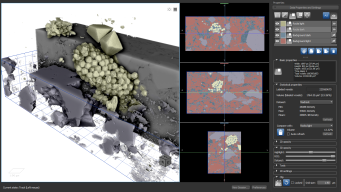Regions of Interest
Image segmentation, also known as classification or labelization and sometimes referred to as reconstruction in some fields, is the process of partitioning an image into multiple segments or sets of voxels that share certain characteristics. The main goal of segmentation is to simplify or change the representation of an image into something that is more meaningful and easier to analyze. Once a segmentation has been completed, statistics can be easily computed. Another objective of segmentation is to organize an image into higher-level units, such as meshes, graphs, and vector fields, that are more efficient for visualization and further analysis (see 3D Modeling).
Segmented image (with clipping)
A region of interest is simply a set of labeled voxels within a shape that has a specific size and spacing. It does not contain data, only labeled voxels. However, when combined with a dataset of the same shape, you can extract parameters such as the minimum, maximum, and mean values of the dataset within the volume of the ROI. With Dragonfly you can create an unlimited number of regions of interest. You can also apply an ROI to different datasets taken of the same object with different modalities or at different times to refine an ROI.
In 3D views, regions of interest can be extracted from volumes to create views containing only segmented areas, or they can be subtracted to create views of everything except the regions of interest (see 3D Opacity).
In simple cases, environments may be well enough controlled so that the segmentation process reliably extracts only the parts that need to be analyzed further. In complex cases in which boundary insufficiencies are present, such as missing edges or a lack of contrast between foreground and background regions, segmentation can be more difficult. In either case it is important to understand that:
- There is no universally applicable technique that will work for all types of images.
- No segmentation technique is perfect.
- Post-processing, by smoothing noisy images or enhancing edges, can accelerate some segmentation tasks (see Image Filtering).
- If you are segmenting large volumes, it may be helpful to simplify the volume before segmentation (see Cropping Datasets).
The Segment tools are arranged in panels that provide options for creating regions of interest, applying operations to ROIs, automatically segmenting image data, and exporting ROIs as meshes. Click the Segment tab on the left side of the workspace to show the Segment tool panels.
Segment tool panels
A. ROI Painter panel B. ROI Tools panel C. Segment with Classifier panel
The tools on the ROI Painter panel are used for manual segmentation and for editing regions of interest in 2D and 3D views (see ROI Painter Tools).
The ROI Tools panel provides tools for creating regions of interest, defining intensity ranges, and for applying operations to modify regions of interest (see ROI Tools Panel).
The Segment with Classifier feature lets you automatically segment image data with any of the classifiers that you created or downloaded for trainable segmentation (see Segmenting Image Data with Trained Classifiers).



